steering wheel BMW 330Ci CONVERTIBLE 2001 E46 Owner's Manual
[x] Cancel search | Manufacturer: BMW, Model Year: 2001, Model line: 330Ci CONVERTIBLE, Model: BMW 330Ci CONVERTIBLE 2001 E46Pages: 215, PDF Size: 2.1 MB
Page 10 of 215
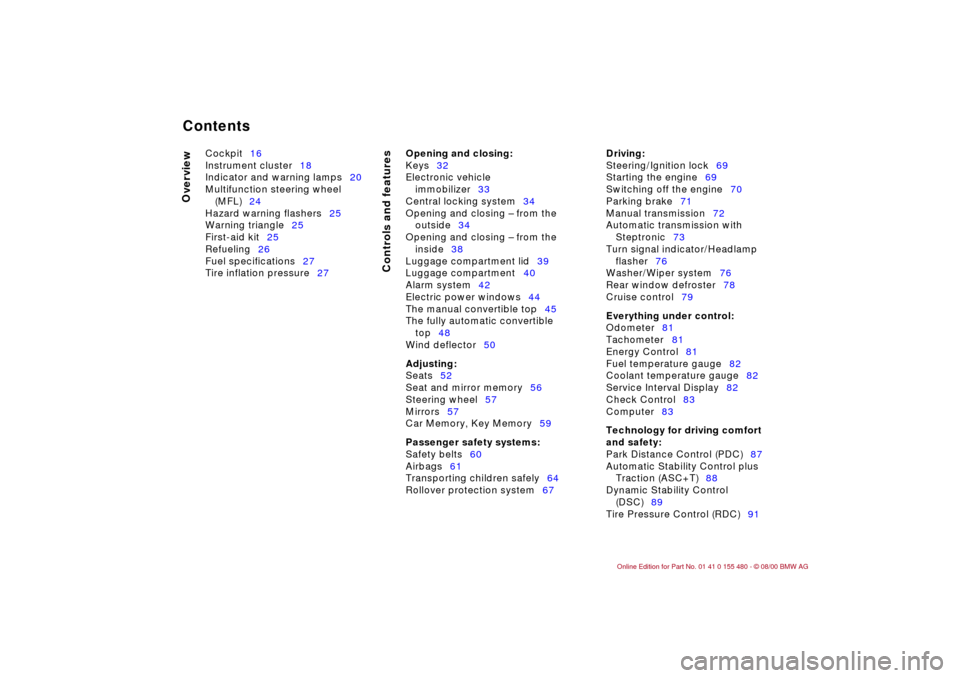
Contents
Overview
Controls and features
Cockpit16
Instrument cluster18
Indicator and warning lamps20
Multifunction steering wheel
(MFL)24
Hazard warning flashers25
Warning triangle25
First-aid kit25
Refueling26
Fuel specifications27
Tire inflation pressure27
Opening and closing:
Keys32
Electronic vehicle
immobilizer33
Central locking system34
Opening and closing Ð from the
outside34
Opening and closing Ð from the
inside38
Luggage compartment lid39
Luggage compartment40
Alarm system42
Electric power windows44
The manual convertible top45
The fully automatic convertible
top48
Wind deflector50
Adjusting:
Seats52
Seat and mirror memory56
Steering wheel57
Mirrors57
Car Memory, Key Memory59
Passenger safety systems:
Safety belts60
Airbags61
Transporting children safely64
Rollover protection system67
Driving:
Steering/Ignition lock69
Starting the engine69
Switching off the engine70
Parking brake71
Manual transmission72
Automatic transmission with
Steptronic73
Turn signal indicator/Headlamp
flasher76
Washer/Wiper system76
Rear window defroster78
Cruise control79
Everything under control:
Odometer81
Tachometer81
Energy Control81
Fuel temperature gauge82
Coolant temperature gauge82
Service Interval Display82
Check Control83
Computer83
Technology for driving comfort
and safety:
Park Distance Control (PDC)87
Automatic Stability Control plus
Traction (ASC+T)88
Dynamic Stability Control
(DSC)89
Tire Pressure Control (RDC)91
Contents
Page 11 of 215

11n
Controls and features
Operation, care and maintenance
Lamps:
Side lamps/Low beams93
Instrument panel lighting93
High beams/Parking lamps94
Fog lamps94
Interior lamps94
Controlling the climate
for pleasant driving:
Air conditioner96
Automatic climate control102
Seat heating107
Interior convenience:
Glove compartment107
BMW Universal Transmitter108
Storage facilities110
Cellular phone111
Ashtray, front111
Cigarette lighter112
Ashtray, rear112
Loading and transporting:
Ski bag113
Cargo loading114
Roof-mounted luggage rack for
the hardtop116
Special operating instructions:
Break-in procedures120
Driving notes121
Catalytic converter121
Antilock Brake System
(ABS)122
Disc brakes125
Brake system126
Winter operation127
Power steering129
Cellular phone129
Radio reception129
Hardtop130
Wheels and tires:
Tire inflation pressure132
Tire condition132
Tire replacement133
Tire rotation134
Wheel and tire
combinations135
Winter tires136
Snow chains136
Approved wheel and tire
specifications137
Under the hood:
Hood140
Engine compartment142
Washer fluids144
Washer nozzles144
Engine oil145
Coolant147
Brake fluid148
Vehicle Identification
Number149
Care and maintenance:
The BMW Maintenance
System150
Caring for your vehicle151
Cleaning and care of the
convertible top157
Airbags159
Vehicle storage160
Laws and regulations:
Technical modifications161
California Proposition
65 Warning161
ODB interface socket162
Page 15 of 215

Overview
Controls and features
Operation, care
and maintenance
Owner service procedures
Technical data
Index Advanced technology
15n
IndexDataTechnologyRepairsCar careControlsOverview
Cockpit16
Instrument cluster18
Indicator and warning lamps20
Multifunction steering wheel
(MFL)24
Hazard warning flashers25
Warning triangle25
First-aid kit25
Refueling26
Fuel specifications27
Tire inflation pressure27
Overview
Page 17 of 215

17n
IndexDataTechnologyRepairsCar careControlsOverview
Cockpit
1 Side lamps/Low beams93
2
d
Turn signal indicator76
>
Parking lamps94
>
High beams94
>
Headlamp flasher76
>
Computer83
3 Washer/Wiper system76
4 Shift lever/Selector lever72
For vehicles equipped with manual
transmission:
To shift into reverse, push the gear
shift lever to the left, overcoming
the slight resistance
5 Hazard warning flashers25
6 Central locking system34
7 Rear window defroster78
8 Horn: the entire surface functions as
the horn
9 Adjusting steering wheel57
10 Fog lamps94
Page 23 of 215
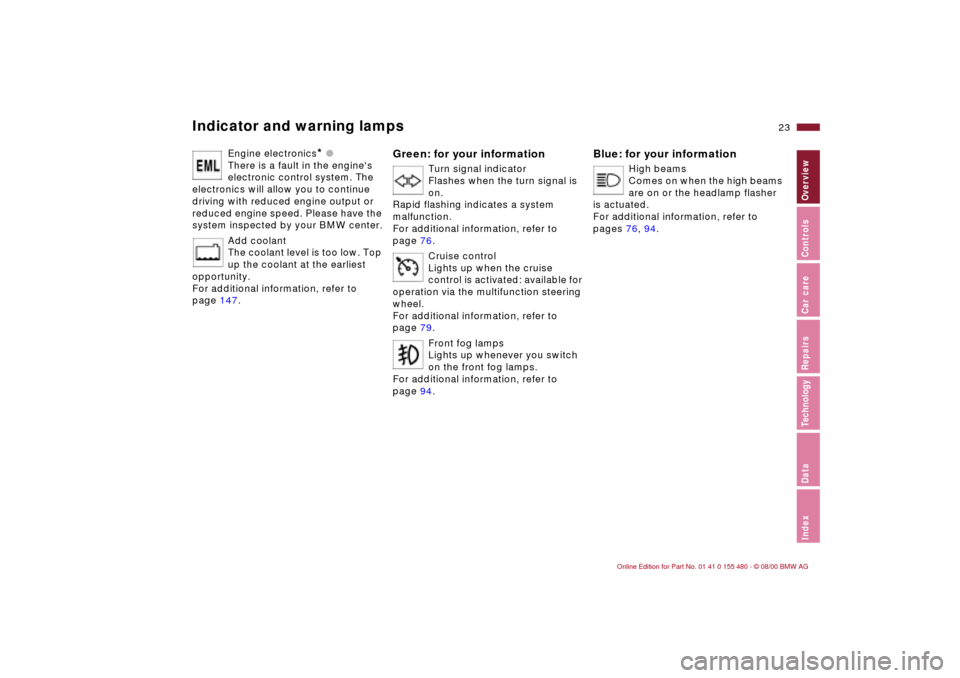
23n
IndexDataTechnologyRepairsCar careControlsOverview
Indicator and warning lamps
Engine electronics
* l
There is a fault in the engine's
electronic control system. The
electronics will allow you to continue
driving with reduced engine output or
reduced engine speed. Please have the
system inspected by your BMW center.
Add coolant
The coolant level is too low. Top
up the coolant at the earliest
opportunity.
For additional information, refer to
page 147.
Green: for your information
Turn signal indicator
Flashes when the turn signal is
on.
Rapid flashing indicates a system
malfunction.
For additional information, refer to
page 76.
Cruise control
Lights up when the cruise
control is activated: available for
operation via the multifunction steering
wheel.
For additional information, refer to
page 79.
Front fog lamps
Lights up whenever you switch
on the front fog lamps.
For additional information, refer to
page 94.
Blue: for your information
High beams
Comes on when the high beams
are on or the headlamp flasher
is actuated.
For additional information, refer to
pages 76, 94.
Page 24 of 215

24n
Multifunction steering wheel (MFL)
The controls integrated in the multi-
function steering wheel are provided
so that you can operate a number of
accessories quickly and without being
distracted from traffic conditions. You
may operate:
>Selected radio functions,
>the cruise control,
>selected cellular phone functions.
In order to operate a system via
the MFL, the corresponding
systems must be switched on.<
Refer to the individual accessory
manuals for more detailed descriptions.
1 Radio/Telephone: select
2 Telephone: receive a call, initiate
dialing and terminate a call
3 Radio/Telephone: volume
4 Radio/Telephone: scan backward or
scan station keys or scroll through
the phone listings
5 Radio/Telephone: scan forward or
scan station keys or scroll through
the phone listings46cde085
6 Horn: the entire surface functions as
the horn
7 Cruise control: activate stored setting
(resume)
8 Cruise control: store and acceler-
ate (+); decelerate and store (Ð)
9 Cruise control: activate/interrupt/
deactivate
Page 30 of 215
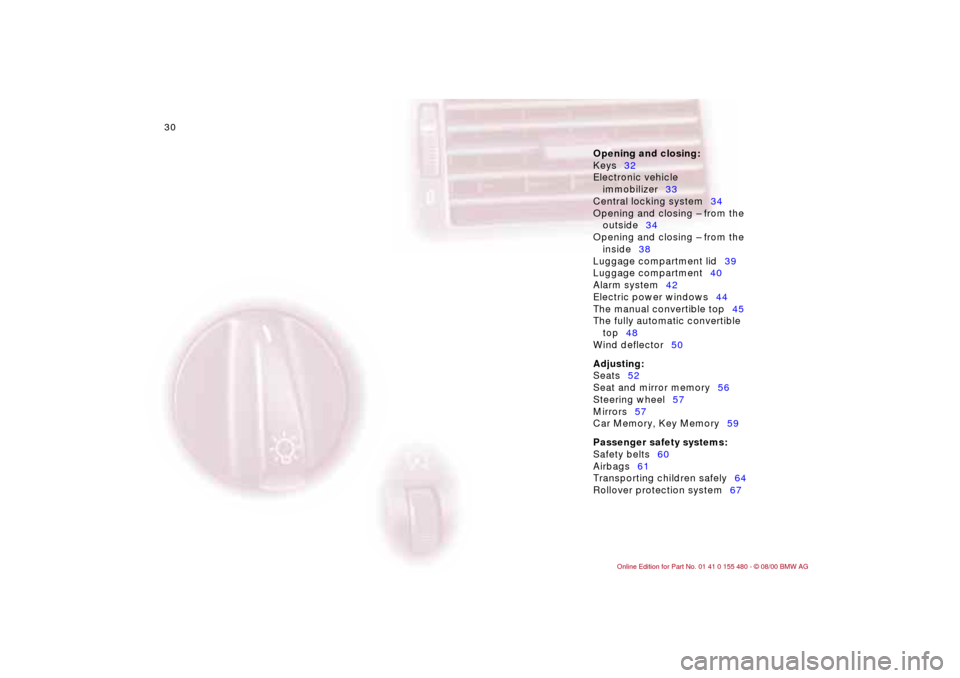
30n
Opening and closing:
Keys32
Electronic vehicle
immobilizer33
Central locking system34
Opening and closing Ð from the
outside34
Opening and closing Ð from the
inside38
Luggage compartment lid39
Luggage compartment40
Alarm system42
Electric power windows44
The manual convertible top45
The fully automatic convertible
top48
Wind deflector50
Adjusting:
Seats52
Seat and mirror memory56
Steering wheel57
Mirrors57
Car Memory, Key Memory59
Passenger safety systems:
Safety belts60
Airbags61
Transporting children safely64
Rollover protection system67
Controls
Page 52 of 215
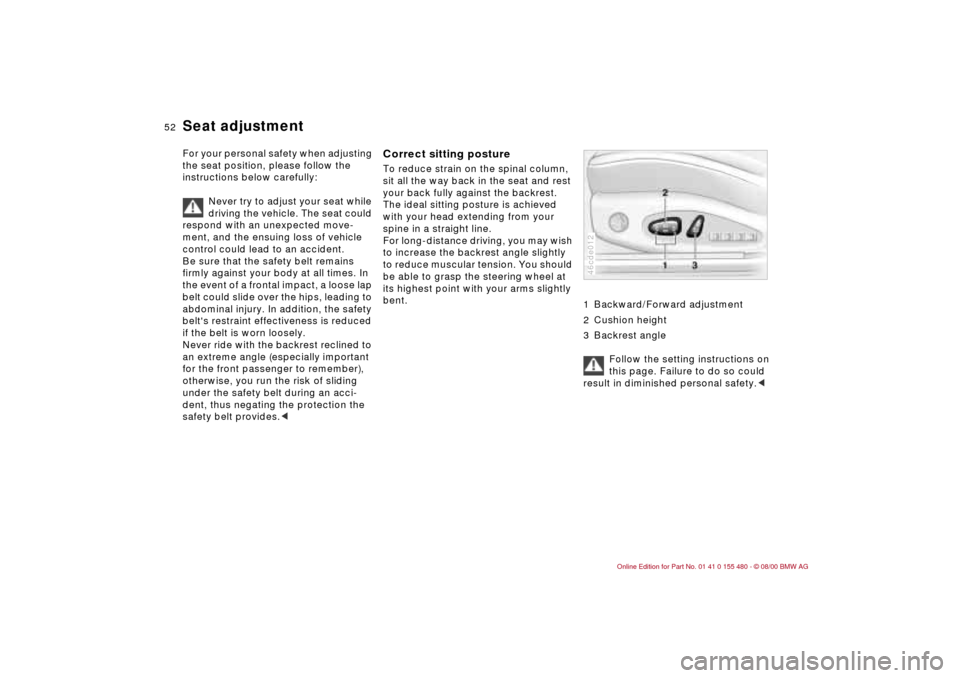
52n
For your personal safety when adjusting
the seat position, please follow the
instructions below carefully:
Never try to adjust your seat while
driving the vehicle. The seat could
respond with an unexpected move-
ment, and the ensuing loss of vehicle
control could lead to an accident.
Be sure that the safety belt remains
firmly against your body at all times. In
the event of a frontal impact, a loose lap
belt could slide over the hips, leading to
abdominal injury. In addition, the safety
belt's restraint effectiveness is reduced
if the belt is worn loosely.
Never ride with the backrest reclined to
an extreme angle (especially important
for the front passenger to remember),
otherwise, you run the risk of sliding
under the safety belt during an acci-
dent, thus negating the protection the
safety belt provides.<
Correct sitting postureTo reduce strain on the spinal column,
sit all the way back in the seat and rest
your back fully against the backrest.
The ideal sitting posture is achieved
with your head extending from your
spine in a straight line.
For long-distance driving, you may wish
to increase the backrest angle slightly
to reduce muscular tension. You should
be able to grasp the steering wheel at
its highest point with your arms slightly
bent.
1 Backward/Forward adjustment
2 Cushion height
3 Backrest angle
Follow the setting instructions on
this page. Failure to do so could
result in diminished personal safety.<
46cde012
Seat adjustment
Page 57 of 215
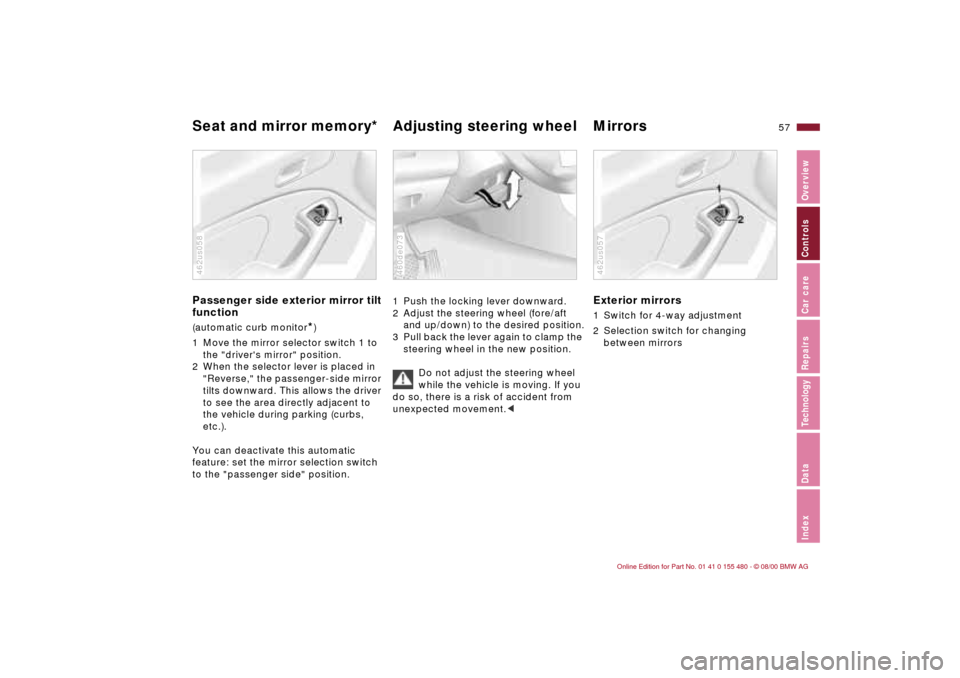
57n
IndexDataTechnologyRepairsCar careControlsOverview
Seat and mirror memory*
Adjusting steering wheel Mirrors
Passenger side exterior mirror tilt
function(automatic curb monitor
*)
1 Move the mirror selector switch 1 to
the "driver's mirror" position.
2 When the selector lever is placed in
"Reverse," the passenger-side mirror
tilts downward. This allows the driver
to see the area directly adjacent to
the vehicle during parking (curbs,
etc.).
You can deactivate this automatic
feature: set the mirror selection switch
to the "passenger side" position.
462us058
1 Push the locking lever downward.
2 Adjust the steering wheel (fore/aft
and up/down) to the desired position.
3 Pull back the lever again to clamp the
steering wheel in the new position.
Do not adjust the steering wheel
while the vehicle is moving. If you
do so, there is a risk of accident from
unexpected movement.<460de073
Exterior mirrors1 Switch for 4-way adjustment
2 Selection switch for changing
between mirrors462us057
Page 62 of 215
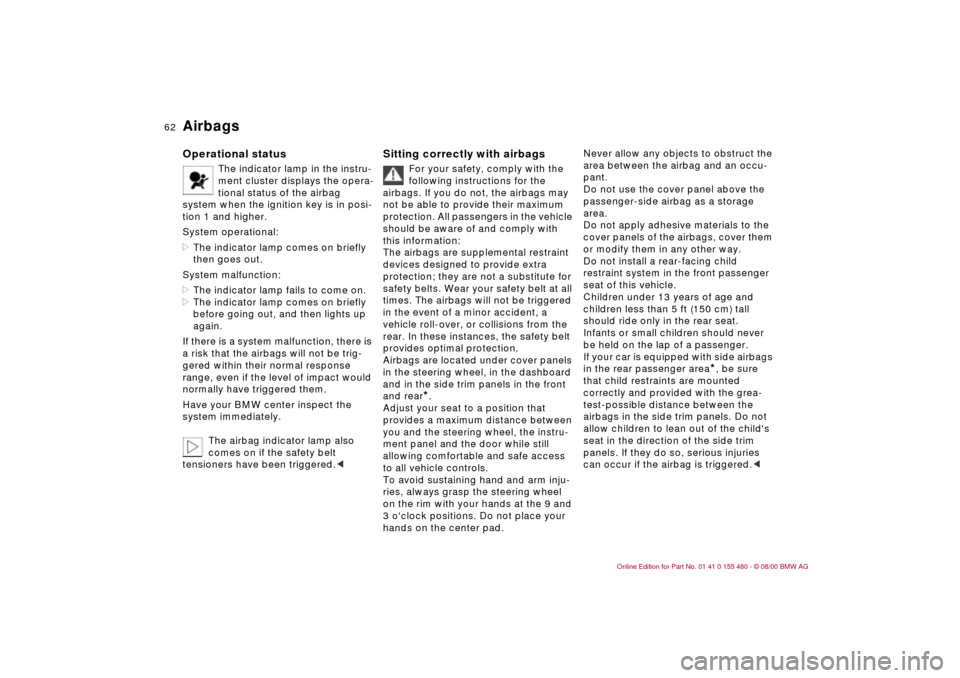
62n
AirbagsOperational status
The indicator lamp in the instru-
ment cluster displays the opera-
tional status of the airbag
system when the ignition key is in posi-
tion 1 and higher.
System operational:
>The indicator lamp comes on briefly
then goes out.
System malfunction:
>The indicator lamp fails to come on.
>The indicator lamp comes on briefly
before going out, and then lights up
again.
If there is a system malfunction, there is
a risk that the airbags will not be trig-
gered within their normal response
range, even if the level of impact would
normally have triggered them.
Have your BMW center inspect the
system immediately.
The airbag indicator lamp also
comes on if the safety belt
tensioners have been triggered.<
Sitting correctly with airbags
For your safety, comply with the
following instructions for the
airbags. If you do not, the airbags may
not be able to provide their maximum
protection. All passengers in the vehicle
should be aware of and comply with
this information:
The airbags are supplemental restraint
devices designed to provide extra
protection; they are not a substitute for
safety belts. Wear your safety belt at all
times. The airbags will not be triggered
in the event of a minor accident, a
vehicle roll-over, or collisions from the
rear. In these instances, the safety belt
provides optimal protection.
Airbags are located under cover panels
in the steering wheel, in the dashboard
and in the side trim panels in the front
and rear
*.
Adjust your seat to a position that
provides a maximum distance between
you and the steering wheel, the instru-
ment panel and the door while still
allowing comfortable and safe access
to all vehicle controls.
To avoid sustaining hand and arm inju-
ries, always grasp the steering wheel
on the rim with your hands at the 9 and
3 o'clock positions. Do not place your
hands on the center pad.
Never allow any objects to obstruct the
area between the airbag and an occu-
pant.
Do not use the cover panel above the
passenger-side airbag as a storage
area.
Do not apply adhesive materials to the
cover panels of the airbags, cover them
or modify them in any other way.
Do not install a rear-facing child
restraint system in the front passenger
seat of this vehicle.
Children under 13 years of age and
children less than 5 ft (150 cm) tall
should ride only in the rear seat.
Infants or small children should never
be held on the lap of a passenger.
If your car is equipped with side airbags
in the rear passenger area
*, be sure
that child restraints are mounted
correctly and provided with the grea-
test-possible distance between the
airbags in the side trim panels. Do not
allow children to lean out of the child's
seat in the direction of the side trim
panels. If they do so, serious injuries
can occur if the airbag is triggered.<